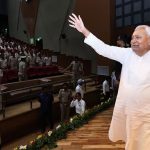Is There a Plan?
India’s economy is in crisis and there exist ways to address it. But it looks as if little will happen until a new government takes office
 Devangshu Datta
Devangshu Datta
 Devangshu Datta
|
05 Sep, 2013
Devangshu Datta
|
05 Sep, 2013
/wp-content/uploads/2015/11/plan-lead.jpg)
India’s economy is in crisis and there exist ways to address it. But it looks as if little will happen until a new government takes office
Sometime in 2014, President Pranab Mukherjee will administer the oath of office to India’s next Prime Minister and his or her colleagues. That assortment of politicians, whoever they may be, will have a tough task on their hands.
First, the new government will have to stem an ongoing crisis of confidence and find ways to revive economic activity. In the long run, it will need to put national finances back in order and generate employment for tens of millions. In order to do this, it will also need to persuade investors to pump more than a trillion US dollars into the economy over the next five years.
This will require a lot of policy restructuring and the political will to get things done quickly in order to minimise the inevitable pain. Not only is the task daunting in its magnitude, it is unclear how any political party actually intends to set about it. The two national parties have so far avoided revealing their economic intentions. This is especially worrisome because by the time the next government assumes charge in 2014, it will have a full-blown recession to deal with.
» WHAT HAS GONE WRONG?
To understand what the next government needs to do, we need to know what has gone wrong. The short answer is everything. India is doing badly on almost every economic indicator. The country’s GDP growth fell to a four-year low of 4.4 per cent in the April-June 2014 quarter and shows signs of further decline. Every financial institution, be it in India or abroad, has downgraded expectations of GDP growth. The most optimistic estimates are that full-year growth will be just above 5 per cent, while the pessimistic are in the range of 3.7 per cent. Consensus expectations are in the range of 4.25-4.75 per cent.
This is actually not growth but recession by global statistical standards. GDP data is always adjusted for inflation to figure out real growth. For example, if nominal growth is 10 per cent and inflation is 5 per cent, real growth after inflation is a little under 5 per cent.
Most countries use consumer price inflation as a benchmark for inflation adjustment. India uses wholesale prices. In the April-June 2013 quarter, wholesale price inflation ran at roughly 5 per cent. However, Consumer Inflation ran at over 9.5 per cent. If India were to use CPI like the rest of the world, the country’s GDP would have shrunk in real terms. What is more, in CPI terms, the economy has been shrinking for the last nine months.
The difference in method is not just a statistical detail. Consumer inflation affects the aam aadmi. As far as individual Indians are concerned, the economy is in recession and has been so for quite a while. This has affected sentiment. People have cut down on consumption and this, in turn, is causing a vicious cycle of falling demand. Car sales, for example, have dropped for the past nine months. Now, the auto industry has a long value chain. At one end, it uses commodities like metals, glasses, plastics, etcetera. It also uses sophisticated electronic instruments and mechanical components sourced from different suppliers. The finished product is put in showrooms, marketed and sold, usually with consumer financing involved. Thus, the auto-industry supports multiple industries from mining to financial services. If it’s in recession, as it clearly is, the economy is in recession.
Meanwhile, India’s imports exceed exports by a large amount. There is pressure on the rupee, which has already been pushed down to historic lows. Inflation is persistent and high and likely to rise further due to the weaker rupee. The Current Account Deficit is near record levels. India cannot cut imports beyond a certain point. It needs to import close to 80 per cent of its crude oil and 30 per cent of its gas. The pressure on foreign exchange reserves is already heavy and it could get more intense. India has roughly $250 billion in forex reserves that could be used instantly. The rest consists of gold, about 560 tonnes, which could be used under extreme circumstances.
This $250 billion represents about five to six months’ worth of imports. But India also has about $170 billion worth of external debt obligations to repay this fiscal year.
Take that away, and the country’s reserves would drop to a shaky two months. And, there is a Sword of Damocles hanging over the RBI because of the nature of capital inflows. While the Government has been keen to lure Foreign Direct Investment (FDI), what India has been attracting in significant sums from abroad are investments in tradeable assets like stocks and bonds; and on current estimates, Foreign Institutional Investors (FIIs) hold about $140-150 billion worth of rupee assets. This is mostly equity and some government debt. That money could, in theory, leave within a few days. In just the past three months, FIIs have sold assets of about $3.5 billion. This has been enough to pull stockmarkets down by 15 per cent and push the rupee down by over 20 per cent. Think of what will happen if FIIs keep selling.
Some 40-odd Indian corporations, which raised money abroad using hybrid instruments called Foreign Currency Convertible Bonds—which gives holders an option of converting their loans into equity—are now struggling to repay what they owe in foreign currency; the high dollar and low share prices (and prospects) have led to their creditors preferring not to convert their bonds into shares, as some of these firms had hoped they would. Some firms have already defaulted on the FCCBs they had issued. There will be more. Of that, you can be sure.
The Government is desperately trying to conserve foreign exchange by raising customs duty on gold, hoping to restrict imports of the metal. It is also looking for other ways to boost reserves. It has started to ease senseless and complex regulations that restrict inflows of FDI. It has also started to ‘fast-track’ clearances for projects.
However, this situation has triggered risk-aversion. The day the Centre announced FDI reforms in the telecom, defence, retail sectors, Korean steel major Posco pulled out of its Rs 30,000 crore Karnataka steel project. The next day, Arcelor Mittal pulled out of Odisha, cancelling its plans to build a Rs 40,000 crore steel plant.
At this instant, even Indians would prefer to invest abroad. Apollo Tyres, Airtel, Tata Motors, Tata Steel, Adani, Shree Renuka Sugars, Hindalco—this is just a random sample of Indian companies that have kicked off major overseas projects instead of investing at home. If India does suffer a sovereign rating downgrade or two by global credit rating agencies, and this is highly probable, investors could stampede for the exit.
India’s Fiscal Deficit is already huge and likely to get larger, given populist schemes like the Centre’s Food Security Bill and its unwillingness to cut subsidies in the face of an impending General Election. National savings have also fallen to a low of about 30 per cent of GDP from a high of 36 per cent in 2007-08, when the economy was in boom. Since it is domestic savings rather than FDI that must fund most projects, this decline makes it harder to kickstart the economy through investment.
Internal accruals are in bad shape. Corporate earning projections have been downgraded for 2013-14 after the year’s first-quarter results came in. Rupee interest rates are rising and banks are saddled with loans that are not being repaid.
Projects worth over Rs 500,000 crore in investment terms are stalled for one reason or another, such as land acquisition difficulties, environmental issues or other statutory clearances. The recently constituted Cabinet Committee on Investments (CCI) has cleared many of those projects after they were in limbo for years, but they are yet to be implemented.
In addition, large-scale corruption has been responsible for huge losses and led to litigation that has, for example, jammed the country’s coal and iron mining industries while causing complications in telecom.
India has a terrible reputation as a place to do business. The International Finance Corporation, in its Doing Business 2013 Report, ranked India 132th out of 185 countries on ‘ease of doing business’. Its rank was 184 in enforcing contracts, 182 in dealing with construction permits, 173 in starting a business, 152 in paying taxes and 127 in crossborder trading. It takes 27 days to start a business in India, versus 19 in South Asia as a whole and 12 in OECD countries.
Being in election mode, the Government’s will to tackle this situation is suspect. In addition to the Food Security Bill, we can expect even more populist measures such as bank loans to farmers being forgiven and power and fuel charges kept down even as their costs soar. To add to those problems, a war in the Middle East could force crude oil prices up. Also, the US central bank is likely to start tapering its money supply. Since September 2012, the US Federal Reserve has carried out its ‘Quantitative Expansion 3 Program’ (QE3), pumping the world with about $85 billion a month in excess liquidity to aid an economic recovery. In the past 11 months, an estimated $12 billion of that money reached India. Now, as the US economy recovers, The Fed is on the verge of cutting back QE3. Some of that money will inevitably flow right back. So, India does not just have a slowdown that’s better described as a recession, it has currency woes, high inflation, poor infrastructure, endemic corruption and an elderly hidebound political leadership that appears unwilling to do what needs to be done.
» WHAT DOES INDIA HAVE GOING FOR IT?
The prospect of being hanged in the morning is said to concentrate the mind wonderfully. The crisis has already forced some action. For example, stalled projects have been cleared. Also, a new Land Acquisition Act has been passed as well as a new Companies Act.
The currency weakness in itself may bring long-run benefits. It forces down imports and could boost exports, which did jump 12 per cent in July. The weak rupee has also led to a review of fuel subsidies, including monthly hikes in diesel prices and a cap on the supply of subsidised cooking gas.
A full-blown currency crisis could force the Government to eliminate more subsidies, not just on fuel but also on fertilisers, which are made from petrochemicals. This would be good for the economy in the long run. India will always be a major energy importer and it cannot afford to subsidise imports. High energy prices could also lead to reforms in the inefficient State-controlled power sector and in the coal-mining industry.
» DO MORE PEOPLE CARE ABOUT THE ECONOMY?
Despite being obscured by the gloom and doom of the past two years, there have been many positive returns from 20 years of reform. Compared to 1991, there’s a much larger middle-class and poverty has certainly reduced, without quibbling over exact numbers. This means that both gains and pains are spread around and the average voter is much more interested in economic development.
One key difference is that in 1991, India did not have a consumer-oriented trading economy. Total trade (imports + exports ) equalled just 14 per cent of GDP. The only direct impact on most people’s lives of a change in currency value was inflation caused by higher fuel prices. Now foreign trade is about 42 per cent of GDP. Everybody, regardless of income level, is affected directly by the falling rupee. Apart from energy prices, cheap mobiles, clothes from Bangladesh, toys, education of children abroad, etcetera, all get more expensive if the rupee weakens. This should make it easier for every political party to develop an economic agenda and focus on reforms. However, no party appears to have woken up to this reality yet.
» WHAT MUST THE NEXT GOVERNMENT DO?
The next government needs to, first, streamline the processes and clearances that hold up any project that needs its approval. India has a combination of the most regressive and complex laws and policies in the world and an extremely corrupt babu-neta nexus. Policies need to be simplified to rid them of discretionary authority and corrupt public servants need to be punished.
Broadly, this agenda could be called ‘good governance’. There are a few state governments that have shown it is possible to deliver this even in India: Bihar, Odisha and Gujarat, for example. It is, in fact, the only concrete economic commitment one can glean from Gujarat Chief Minister Narendra Modi’s public speeches.
Second, India needs a national Goods and Services Tax (GST). Right now, the differing rates at which various states tax various goods results in insane delays in internal trade. It takes more time, trouble and paperwork to move goods from Karnataka to Maharashtra than it does from Poland to the UK. GST could change that.
This new tax has been hanging fire for years now because many states are uncomfortable at the prospect of a switchover. However, similar Centre-state negotiations were involved before Sales Tax could be replaced by Value-Added Tax in 2005. The result, as the VAT opponents of 2005 would admit, has been beneficial to everyone. GST requires similar negotiations, but the next government has to push it through.
Third, labour reform. India’s labour laws are regressive and complicated. There are over 50 national laws and many more state-level laws. For example, any institution with over 100 workers has to seek government approval before it can fire employees or close down. Permanent workers cannot be dismissed except for misconduct. Since firing people is so difficult, nobody wants to hire. Organised labour forms just about 15 per cent of the workforce. No entrepreneur wants to get beyond the threshold limits in hiring permanent staff. This results in Indian manufacturing lacking scale and competitive advantage. There has to be ground-up reforms of labour laws to ensure that manufacturing expands. This is the only way to create the millions of jobs required.
The next government will also have to attract investors. Building India’s infrastructure in itself will take over a trillion USD over the next five years. Global investors will return to India only if they are convinced that the Government is serious about speeding things up and projects are not going to get stuck. For that, multiple policies need to be reviewed and—if necessary—junked and rebooted.
» WHO CAN DO WHAT NEEDS TO BE DONE?
What does any political party aspiring to lead (or be part of) the next government at the Centre intend to do about the crisis? No party or alliance has declared a concrete policy agenda that adequately addresses the situation.
The Congress has waffled about granting rights to citizens such as the Right to Food and Right to Education. However, it has patently failed to create the economic wherewithal to deliver those rights without wrecking national finances. Even in the midst of the current storm, it has just tried to shift the blame rather than take concrete steps to address outstanding issues.
The Bharatiya Janata Party has promised the electorate ‘good governance’. However, Narendra Modi continues to oppose GST and claims that he would actually expand the scale of Food Security giveaways. Both actions would be counter-productive—and, in fact, ruinous.
Among the potential leaders of a Third Front coalition at the Centre, Bihar’s Nitish Kumar and Odisha’s Naveen Patnaik are two with decent governance records. But there is a difference between running a state well and developing the policy skills needed to govern an entire country as complex as this.
Such lack of clarity leaves voters in a quandary. It is also an opportunity for any political party to fill the vacuum with a well-articulated and common-sense economic agenda. Otherwise, I’m likely to chuck names into a hat and pull one out at random when I cast my vote.
About The Author
CURRENT ISSUE
MOst Popular
3

/wp-content/uploads/2025/07/Cover_Crashcause.jpg)











More Columns
Bihar: On the Road to Progress Open Avenues
The Bihar Model: Balancing Governance, Growth and Inclusion Open Avenues
Caution: Contents May Be Delicious V Shoba